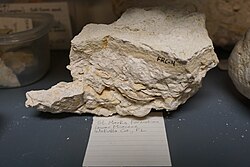| St. Marks Formation | |
|---|---|
| Stratigraphic range: Miocene | |
 | |
| Type | Rock sample from the St. Marks Formation |
| Unit of | None |
| Sub-units | None |
| Lithology | |
| Primary | Limestone & sand |
| Location | |
| Region | Florida Panhandle |
| Country | |
| Extent | Jefferson, Leon, and Wakulla counties |
| Type section | |
| Named for | St. Marks River |
| Named by | J. Finch, 1823 |

The St. Marks Formation is a Miocene geologic formation in the eastern Florida Panhandle.
Age
Period: Neogene
Epoch: Miocene ~23.03 to 5.33 mya, calculates to a period of 17.7 million years
Faunal stage: Arikareean through Hemphillian
Location
The St. Marks Formation is exposed in Wakulla, southern Leon and southern Jefferson County, Florida on the northwestern flank of the Ocala Platform and along with Suwannee Limestone and Ocala Limestone makes up the upper part of the Floridan Aquifer in the eastern panhandle.
Composition
The St. Marks Formation consists of a white to yellowish gray, poorly to moderately hard, sandy, fossil bearing rock in molds and casts within packstone to wackestone.
Fossils
The fossils are in molds and casts and include:
References
- Florida Carbonate "Formations" and Conflicting Interpretations of Injection Well Regulations
- Finch, J., Geological essay on the Tertiary formation in America: American Journal of Science, v. 7, p. 31-43, 1823.